SparkFun RF Transceiver Breakout - RFM22B-S2 (434 MHz)
Here is the breakout board for the RFM22B which gives you access to the pins. The RFM22B is a low-cost ISM (industrial, scientific, and medical) FSK (frequency-shift keying) transceiver module which offers communication at 434MHz and adjustable output power of up to +17 dBm. The wide operating voltage range of 1.8–3.6 V and low current consumption makes the RFM22 an ideal solution for battery powered applications.
Communication with the RFM22B is achieved via a standard 4-wire SPI interface. Three configurable general purpose I/Os are also available, the use of which can be tailored towards the needs of your project. A host of other features are also available including an 8-bit ADC, temperature sensor, RX and TX FIFOs, and low-battery detection. See the datasheet below for a complete description of every register and command.
In our testing, a 17cm wire attached to the 'ANT' pin worked just fine. A hole is drilled next to the 'ANT' pin for strain relief.
- Frequency Range = 434 MHz
- Sensitivity = -118 dBm
- +17 dBm Max Output Power (Configurable)
- Low Power Consumption
- Data Rate = 1 to 128 kbps
- Power Supply = 1.8 to 3.6 V
- Ultra low power shutdown mode
- Digital RSSI
- Wake-on-radio
- Auto-frequency calibration (AFC)
- Configurable packet structure
- Preamble detector
- TX and RX 64 byte FIFOs
- Low battery detector
- Temperature sensor and 8-bit ADC
- -40 to +85 °C temperature range
- Integrated voltage regulators
- Frequency hopping capability
- FSK, GFSK, and OOK modulation
- Low BOM
- Power-on-reset (POR)
- 0.63x0.63in (16x16mm)
- Schematic
- Eagle Files
- Datasheet (RFM22B)
- Product Page
- GitHub
SparkFun RF Transceiver Breakout - RFM22B-S2 (434 MHz) Product Help and Resources
Core Skill: Soldering
This skill defines how difficult the soldering is on a particular product. It might be a couple simple solder joints, or require special reflow tools.
Skill Level: Noob - Some basic soldering is required, but it is limited to a just a few pins, basic through-hole soldering, and couple (if any) polarized components. A basic soldering iron is all you should need.
See all skill levels
Core Skill: Programming
If a board needs code or communicates somehow, you're going to need to know how to program or interface with it. The programming skill is all about communication and code.
Skill Level: Rookie - You will need a better fundamental understand of what code is, and how it works. You will be using beginner-level software and development tools like Arduino. You will be dealing directly with code, but numerous examples and libraries are available. Sensors or shields will communicate with serial or TTL.
See all skill levels
Core Skill: Electrical Prototyping
If it requires power, you need to know how much, what all the pins do, and how to hook it up. You may need to reference datasheets, schematics, and know the ins and outs of electronics.
Skill Level: Rookie - You may be required to know a bit more about the component, such as orientation, or how to hook it up, in addition to power requirements. You will need to understand polarized components.
See all skill levels
Comments
Looking for answers to technical questions?
We welcome your comments and suggestions below. However, if you are looking for solutions to technical questions please see our Technical Assistance page.
Customer Reviews
5 out of 5
Based on 2 ratings:
1 of 1 found this helpful:
Very interesting device. Bit of a learning curve. Jury no longer out.
I purchased this breakout board, looking to find a simple to use alternative to the the RF1100SE or more expensive NTX2B as an FSK transmitter. Big learning curve. Read the documentation. Do not expect the RM22 libraries to work out of the box. By default the power output 4h is set to higher than an Arduino UNO 3.3 volts can supply. I'll be tweaking the library. I did get a successful RTTY transmission before it starts to reboot. Yes I'm taking the Technician level test soon! Google FCC Part 15 about low power unlicensed transmitters.
************** added 25Aug15 *******************
Changing this to a 5 *****
I am using a Sparkfun level shifter between the board and an Arduino UNO
Functional RTTY test code can be found for the UK High Altitude Balloon Project.
http://ava.upuaut.net/?p=408
REM: UK and Europe have different laws about generated radio transmissions and frequency use than the FCC USA.
Refer to Sparkfun's data sheet but also the "Register" PDF from HopeRF the manufacturer of the board. Very handy when reverse engineering code (above). Register 6D's last three bits sets the power level for transmitting.
http://www.hoperf.com/upload/rf/AN440.pdf
I'm using an SDR (Software Defined Radio, 50 MHz to 1.3 GHz) dongle, Amazon/Ebay ~$20 USD to receive the signal using (free) SDR# software and decoding it using (free) Dl-figi software. Soooooooo sweet!
Enjoy.
Good product
Frequency is within 2 KHz of nominal. Sounds good. We were able to hear it on My FT-817 and similar rigs up to 23 miles away, ONLY if there is a clear line of sight (no trees etc in the way). We placed transmitter on top of Mt Greylock in Western MA. This product is being used by FCC Licensed amateur radio operators. I believe you need to have a license to use this product. You may want to contact the American Radio Relay League http://arrl.org for more information.

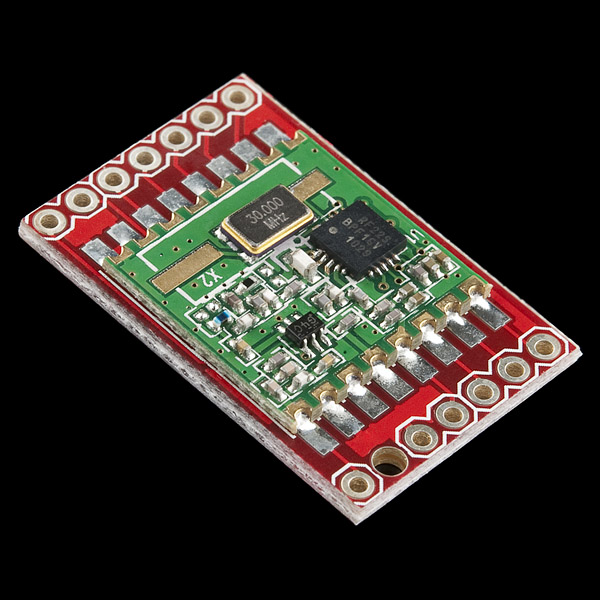
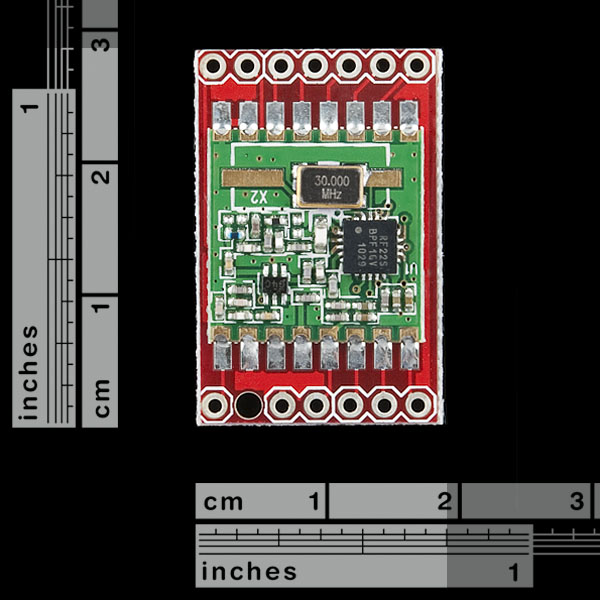
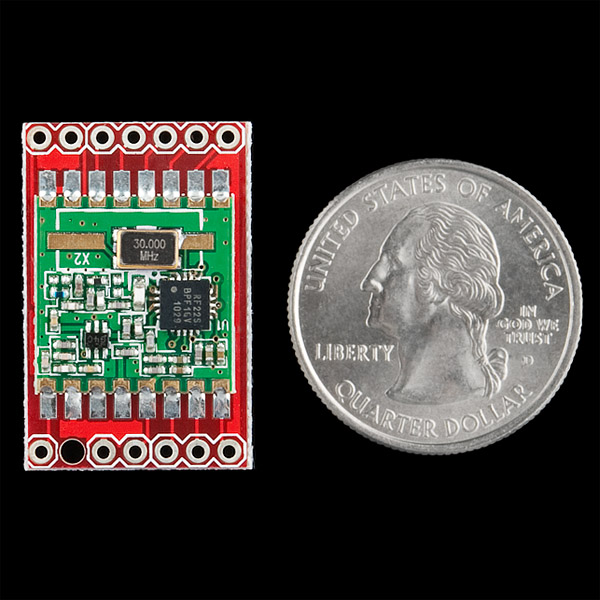
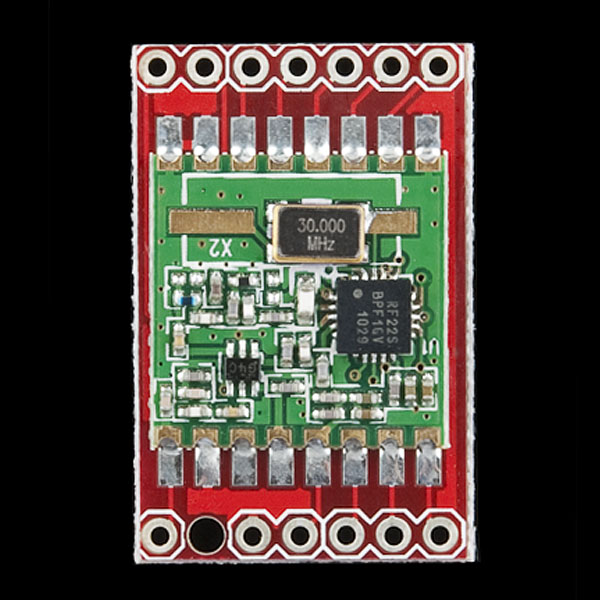
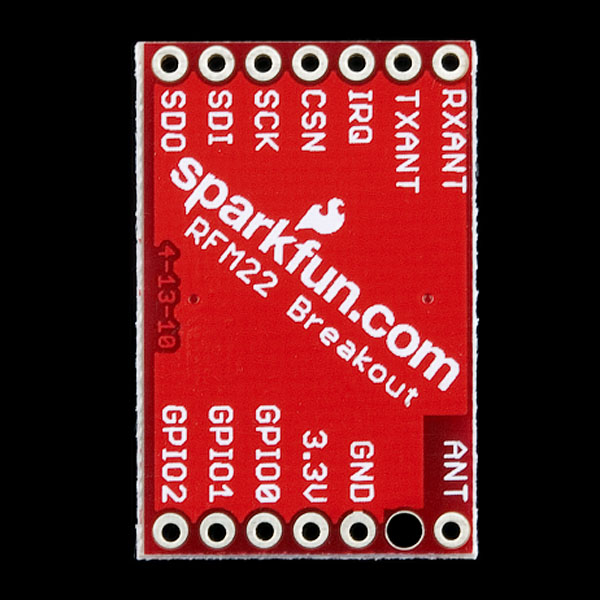
The page mentions "Wake-on-radio" but all I can find in the datasheet is "Wake-up timer", which is very different. Does it actually have a wake-on-radio feature that I'm missing?
Can I change the frequency by reprogramming it?
RFM22B-S2 = $11.95 RFM22B-S2 BoB = $22.95
What's going on with the prices? A piece of a tiny PCB is worth $11 (!!!) ?
This breakout board includes the radio module.
Well, it better be! Please read my comment again.
Oops.. I misread!
Given the price I am now thinking of directly soldering wires to the module terminals instead of using this board.
I've got this item, which is good, but if you want something with better performance I'd probably recommend the Modtronics RFM22B Breakout
I've used both the sparkfun and Modtronics version. I have them setup on breadboards and have been controlling them with Arduino's (there's a really good Arduino RFM22B library out there). They both work great, except I get about 150m further range out of the Modtronics version and that is just using the basic stub antenna they sell. Attach a Yagi antenna or similar and you'd get heaps further again.
Good radios the RFM22Bs!
Ta - they look good.
I know it is very environmentally / terrain dependent, but how far do you get out of the radios? I'm having some problems getting the distance I need out of the Sparkfun units, so I was hoping the ones you mentioned (at least at one end of the link) might help me.
As you say it is very dependent. I'm currently getting a 1km'ish in town (low rise houses) out of the Modtronics modules. I've done a small amount of testing in open terrain and I've got many km's out of them. The RFM22B modules have excellent range.
Wow that is quite a lot further than I get out of my ones. Think I'm going to buy some of yours, these are it aren't they? They seem to have a few http://modtronicsaustralia.com/shop/rfm22b-s2-rf-transceiver-breakout-board-v2/
This board is truly a work of art.
Which pin are connected to the antenna?
I'm new when it comes to electronics, how do you wire it???
Ultra low power? why didn't you break out the SDN (shutdown) PIN? More even when there is one pin left unused? the 15 nA shutdown mode is selected by using this pin, isn't it? ... Am I missing something?
Is this compatible with the RFM12?
http://mbed.org/users/charly/notebook/rfm22/#c2734 has example code for mbed.
Here is a link to an RF22 library for use with Arduino. Really helped me out to get this working with a pair of Arduino Pro Minis.
http://www.open.com.au/mikem/arduino/RF22/
Talk about working out of the box. Highly recommend!!
We have also had good results using that library. It is a great starting point for getting this module working. We've made a board that is kind of like a cross between this board and a Pro Mini. So far it is working great using the library from open.com.au
Is this just the breakout board or does the RFM22B/23B ISM TRANSCEIVER MODULE come all ready attached to same. Pls let me know ASAP because I just ordered 4ea of the transceiver modules. If so is the boards available by them selves?
Thank you once again for your time and assistance. RTL
it has the transceiver module.
For those of us who already have the transceiver module, is the bare board available?
A breakout board for a breakout board?
What is the difference between the SMD and DIP version of this chip? It seems like the DIP version would be the same but easier to use for hobbyists?
Im confused by the pictures, is this the breakout board for the radio module or the breakout and the radio module as one package.
Seems awfully expensive for just a breakout? twice the cost of the radio.
It comes with the radio module.
Just a side-question: how did you managed to rotate the Sparkfun logo 45 degrees? I've heard that is not possible on EAGLE. I would like to rotate sone TO-92 transistors and other components.
Eagle will let you type in the rotation amount in degrees when you are moving a component, look for it in the top toolbar. Cheers,
This looks like a lot of fun but i am quite the novice. Does anyone have any references to share for implementing something like this?
i think you need to update the specs listed and the datasheet which appear to be for the RFM22 no RFM22B.
Heh...isn't that kind of a BoB for a BoB?
(Insert witty Inception joke here.)
Yo dawg, I heard you like breakout boards...
Interestingly, you can get a 6.5 mile range with a 35 dB fade margin, assuming maximum power and this antenna for both ends: http://search.digikey.com/scripts/DkSearch/dksus.dll?Detail&name=931-1070-ND
Anyone think otherwise? My calculation was pretty sloppy...
I'm using this chip (not this particular module), at 17dbm power setting with matched passive antenna... just over 2 miles max range attained (RSSI level down to around 30). Si-Labs themselves get something similar I think with their dev-kit at 20dbm but I think that's due to the noise floor on the dev kit.
Should have said.. using it at 868MHz